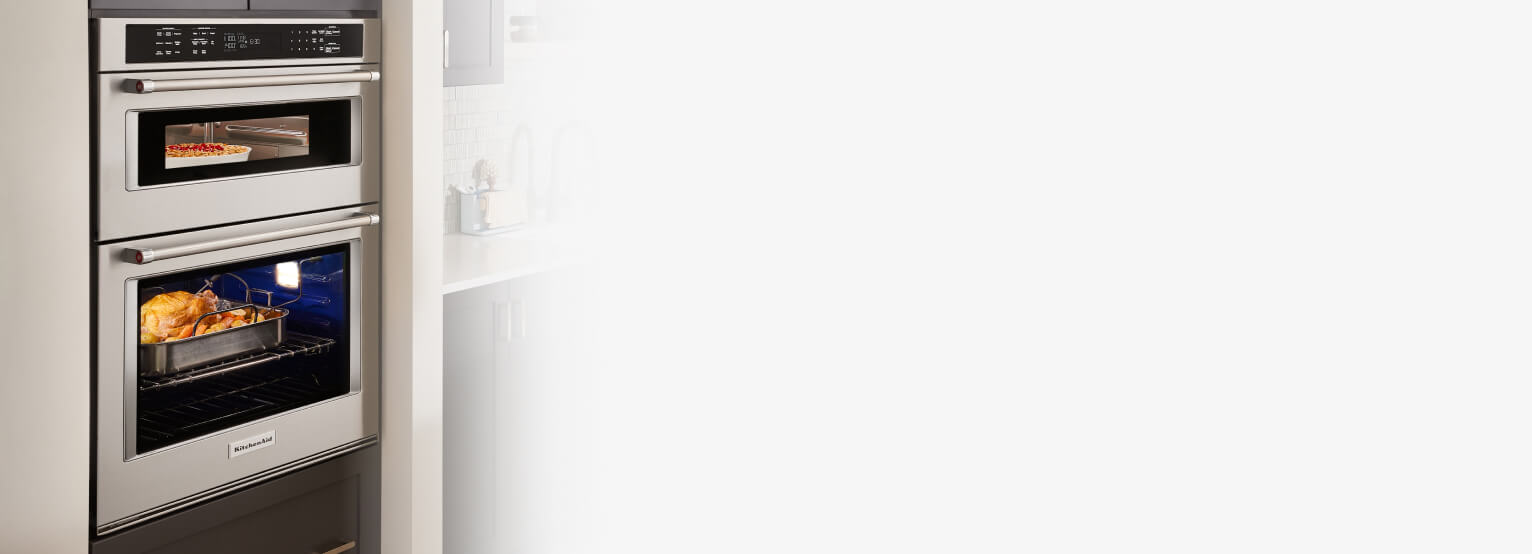
Convection bake vs. bake: What’s the difference?
The main difference between bake and convection bake is in how heat is distributed. With convection bake, an air circulation system distributes air inside the oven cavity. With a conventional oven, two heating elements heat air inside the cavity without the use of a fan to circulate the hot air.
Depending on the model, some convection ovens utilize a third heating element in addition to the fan, called true convection, that can help some foods cook faster than traditional thermal bake settings.
If you have a convection oven or wall oven with convection bake settings, like this model by KitchenAid brand, understanding how different baking cycles work and when to use them can help you achieve the ideal cooking environment for different dishes. Read on to compare convection vs. regular bake and learn when to use convection bake for your recipe.
What is convection bake?
With true convection baking, your oven is able to help maintain optimal temperatures as you cook. The fan used in convection baking helps evenly distribute hot air to help remove excess moisture from the surface of foods and help ensure consistent results across dishes when cooking on multiple racks.
How do convection ovens work?
Convection ovens work by using a fan and exhaust system to circulate air distributed from the heating element throughout the oven cavity. On most convection oven models, convection settings can be turned on or off, giving you the flexibility to cook with conventional thermal settings when you like.
Some convection ovens, like this True Convection range model from KitchenAid brand, feature a third heating element that can help foods cook faster compared to its traditional thermal-bake cycle.
Unlike convection bake, regular bake cycles allow the oven to operate like a conventional, thermal oven. Conventional ovens lack the air distribution system used by convection ovens and instead use heating elements on the top and bottom, which may cause uneven temperatures.
What is convection bake used for?
Convection bake is best used for recipes that could benefit from the even heat distribution of hot air circulated throughout the oven via the fan and exhaust system. This heating method makes convection baking particularly useful for baking multiple batches of cookies or dishes on multiple racks.
When you use convection baking settings, you can elevate your roasted meals by achieving crispy, flavorful skins on meats or delicious caramelization on vegetables.

Compare different types of wall ovens

Need help buying a double wall oven?
Shop KitchenAid® ovens with convection settings
KitchenAid® ovens with convection settings help deliver even cooking results across multiple racks. The unique bow-tie design of the heating element and convection fan help ensure the inside of the entire oven is heated to, and stays at, the right temperature.
What is regular bake?
Baking uses heating elements to surround your food with hot air. As a slower cooking method, this can help enhance flavor in a variety of foods. While many items bake at 350°F, temperatures can range from 200° to 375°F.
The bake setting can be used on both conventional and convection ovens, so you won’t miss out on traditional settings if you opt for a convection oven.
What is regular bake used for?
The bake setting is best for unstructured foods that require slow cooking. The lower temperatures can help the food slowly build structure while retaining moisture. Use the bake setting for sweets like cakes and for foods like casseroles or thicker-cut pieces of poultry or pork.
When to use convection bake vs. bake
In addition to even baking across multiple racks, convection bake settings can help you achieve the ideal environment for cooking specific recipes. Convection settings can fulfill most baking needs and can be used to cook a wide range of foods, including meats, vegetables, casseroles, cookies, pies and more.
Use convection bake to achieve light and flaky baked goods or cook through layered casseroles and pasta bakes. You can also use convection baking to provide the dry environment needed to start experimenting with recipes involving dehydrated or toasted ingredients.
Certain baked goods, however, are best cooked using conventional oven settings. Avoid convection baking foods like cakes, quick breads, custards, and other delicate desserts and pastries.
Convection bake vs. regular bake: Key considerations
The main differences between convection bake and regular bake are the cooking speed, temperature and heat distribution, and the end result. Convection baking is often faster and provides a more consistent bake across multiple racks. Regular bake is preferred for cakes, breads and other delicate desserts due to the slower baking process. If you’re looking for crispy and browned results, you may want to choose convection baking. Keep reading to learn more about key considerations around convection bake vs. regular bake.
1. Cooking speed
Because of the radiant heat produced by conventional oven heating elements, dishes may cook faster or slower depending on their location inside the oven. With a convection oven, the circulated air throughout the oven cavity helps deliver consistent heating to dishes across multiple racks.
Convection baking may also help reduce the likelihood of hot or cold spots in your dishes. As a result, your food may cook faster without the need to rotate dishes or adjust cook times to accommodate uneven heat distribution of regular bake cycles.
When using a convection oven to bake, be sure to check your dishes earlier than what the recipe may say. Begin checking your dishes when 20% to 25% of the baking time is remaining. For example, if you’re baking a pie for an hour, try checking 12 to 15 minutes early, or check one hour early if baking a big roast or turkey that calls for a four-hour cook time. You can also use an oven thermometer to help determine if a dish is done.
2. Temperature & heat distribution
Because convection ovens often bake foods faster than conventional ovens, you may want to adjust the temperature when baking. A good rule of thumb is to reduce the baking temperature by 25°F. Some ovens may adjust the temperature automatically. Read your appliance’s owner’s manual to ensure you are setting the proper temperature for your recipe.
Regular bake may require specific pan placement or rotation to help ensure that foods are evenly baked. With convection baking, you do not need to rotate your dishes or worry about hot or cold spots in your oven.
3. Baking results
Convection baking can result in brown or crispy dishes, which can be ideal for certain meats and pastries. It can also help evenly bake multiple dishes at once or layered pasta dishes. Conventional baking, on the other hand, is a slower process best used for unsolidified foods, like batter or dough. It gently browns the surface of what you’re baking while solidifying the interior.
Which setting is best: Bake or convection bake?
Choosing between bake or convection bake when baking can help you achieve specific results and depends on your personal cooking preferences. You can use convection baking for an even heat distribution across multiple racks and browning or caramelization on dishes, like meats, vegetables and pastas. Conventional baking is often recommended for cakes and certain moist breads. Keep reading to learn more about what setting to use for different types of dishes.
Pizza
The baking and heat distribution of a convection oven provides the ideal environment for making a variety of dishes, including homemade pizza and oven-baked ribs. With convection baking, hot air is delivered to each area of the pizza for even cooking across multiple racks.
On most conventional ovens, heat is usually distributed by the bottom heating element, leaving the crust without targeted heat. With convection baking, you may achieve a crispier crust thanks to the circulated hot air inside the oven cavity. Experiment with the many cooking possibilities of convection bake for other homemade recipes like baked desserts or golden, fluffy loaves of sourdough bread.
Bread
Conventional baking is ideal for some breads, especially those with higher fat content that need to retain moisture. The dry, circulating heat of convection baking is good for other types of bread because of the crust and browning that it can create. Depending on the results you want, and the type of bread you’re making, you can use conventional or convection baking.
Cakes
It’s often recommended to use a conventional oven when baking cakes. The blown air of convection ovens may help cause lopsided results in foods like cake, souffles, custards and flans, while conventional ovens are often better at helping baked goods retain the moisture necessary in many recipes.
Cookies and brownies
Convection baking can help produce a more even bake on cookies across multiple racks and can allow you to bake two sheets at once. If you opt for a conventional oven, it's recommended to only bake one sheet at a time for the best results.
Like cookies, using convection baking for brownies can help create a more even heat distribution across multiple racks without needing to rotate your dish. However, brownies may dry out faster when using convection bake. It comes down to your preference on what type of setting to use.

KitchenAid® wall ovens
Oven designs that inspire
Shop single and double built-in wall ovens to find the option that inspires your creativity and matches the way you make
Shop KitchenAid® ovens
KitchenAid® ranges and wall ovens with Even-Heat™ True Convection combine powerful convection cooking technology with intuitive design to help you achieve consistently delicious results. Browse the full collection of ranges and wall ovens by KitchenAid brand to discover the appliance that’s right for your kitchen.

Destination: Design
Follow the path to inspiration
Join two creative storytellers as they travel to a unique destination, and watch as KitchenAid brand transforms their inspiration into stunning designs








